Excerpts from Jim Conrad's
Naturalist Newsletter
entry dated May 1, 2023, issued from near Tequisquiapan, elevation about 1,900m (6200 ft), Querétaro state, MÉXICO
(~N20.55°, ~W99.89°)
PALE SPIKERUSH
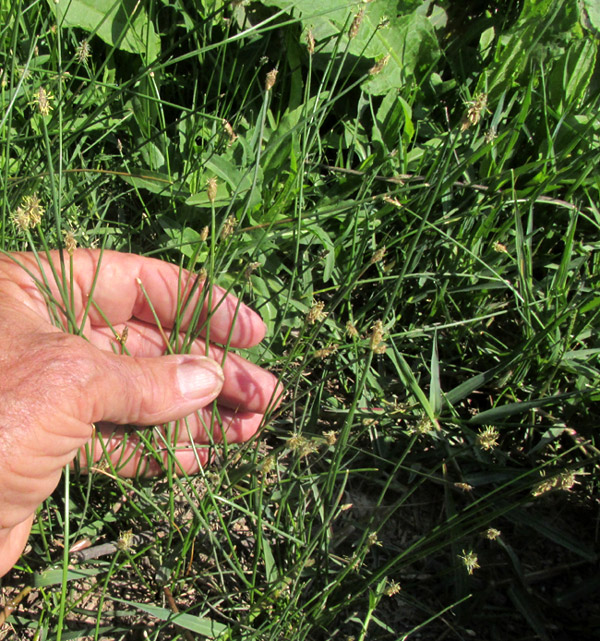
At a low, weedy spot on the floor of a shallow gully occasionally flooded after heavy rains and when local big landowners negligently let their irrigated fields overflow for days, the above slender-stemmed plants with compact flower clusters at stem tips were flowering. Those familiar with common weeds and wildflowers will recognize this general plant form -- small, pineapple-shaped flower clusters atop slender, unbranching stems -- as signifying a species of spikerush, genus Eleocharis, of the Sedge Family, the Cyperaceae.
Identifying spikerushes can be hard. Kew's Plants of the World database currently recognizes 297 accepted spikerush species. And, as the Flora of North America says, "Classification of Eleocharis is unusually difficult because relatively few macroscopic characters are provided by the simple structure characteristic of the genus (only two leaves, basal, without blades or with only rudimentary blades, and unbranched aerial stems, each with a single terminal spikelet and without an involucral bract)."
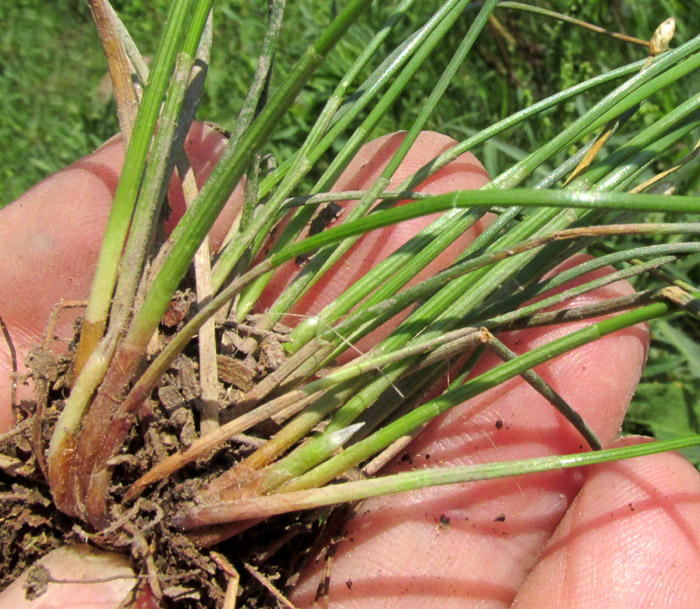
Above it's seen that our spikerush is a perennial with several stems sprouting from a rhizome. Stem are very slender, about 1.5mm thick (1/16inch), roundish in cross-section, and their lower parts arise from papery, brownish-red sheathes. These are good field marks.
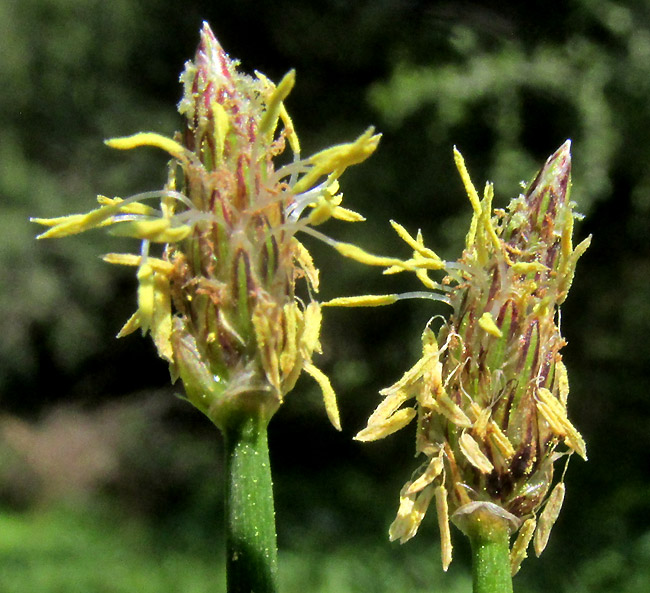
Flowering heads consist of numerous spirally arranged scales inside which flower ovaries are hidden and protected, but from behind which stamens and stigmas emerge. Above, the slender, yellow items are pollen-producing anthers on white, threadlike filaments. Atop the spikes, grainy-looking white things barely emerge; those are the beginnings of stigmas. In a given spike, starting at the bottom, first the flowers' male parts emerge and eject their pollen. Then they shrivel and fall off, as the female parts above them emerge and become receptive to pollen from other plants. The above scales display green midribs edged with purple, with the scales' margins thin and white-clear. At the spikes' bottoms we see three or so broader, thinner, white scales wrapping mostly or entirely around the stem, and having no flowers behind them.
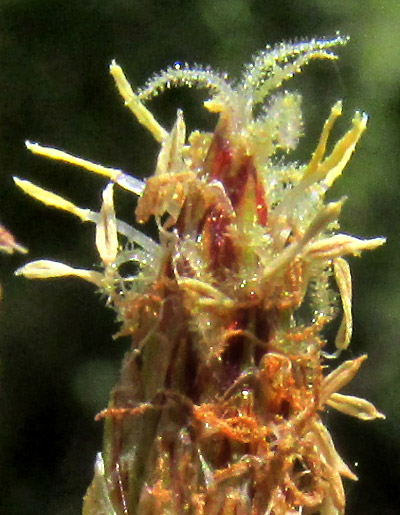
At the right we see a more mature spike, with spent, withered stamens below while, at the top, white style-branches with bristly, stigmatic surfaces gathering pollen emerge from atop the ovary. An important field mark in spikerush identification is whether two or three style branches arise from each ovary. At the right, it's hard to say, but I think each ovary produces two style arms. By bending a spike to expose what's behind a scale, it's seen whether the ovary is convex or three-edged:
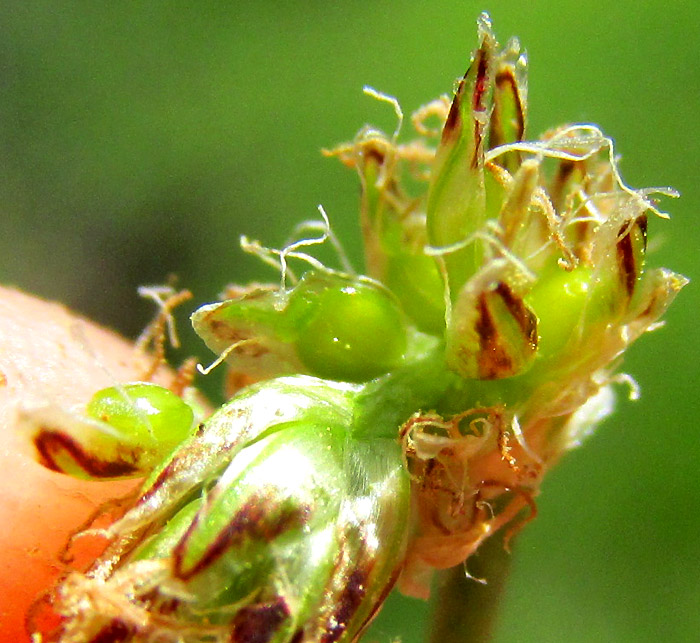
The green, shiny ovary in the picture's center is shaped like a convex lens, and that ovary shape usually bears only two style arms. Finally, here's something surprising on our plant's stem:
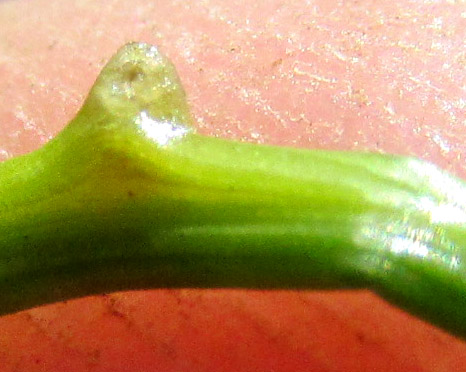
The Flora of North America describes a "tooth" or mucro at the apex of sheathes of certain species. However, their drawings of such teeth are unlike what appears in the above picture. That tooth doesn't appear to be at a sheath apex, though there's some kind of feature interrupting the stem above the tooth, at the picture's right. I'm unsure how to interpret these features.
Since the classification of spikerushes is poorly understood -- even in North America where most studies have been done -- the situation in Mexico surely is even more uncertain. However, at the GBIF Eleocharis page, on the map displaying the genus's worldwide distribution, it's possible to zoom into our part of central Mexico, clicks on "explore" at the map bottom, and be presented with a list of Eleocharis species that been documented here. When details of technical descriptions of each of those species area are taken into account, our plant most matches features of the list's most frequently documented species. That's ELEOCHARIS MACROSTACHYA, in English known mostly as the Pale Spikerush.
Eleocharis macrostachya is native to most of western and central North America, south throughout Mexico, plus in parts of South America. The Flora of North America describes it as an extremely variable species, and quotes studies from the 1960s suggesting that it's a "... diploid-polyploid complex at least partly of hybrid origin from E. palustris and both E. erythropoda and E. uniglumis. The species may spring from three preexisting parent species.
Our plant's "tooth" doesn't look anything like the one in the Flora's drawing, so I wouldn't be surprised if our central Mexican upland plants are a different species, one that's common and much collected, but for which no one has gotten around to study seriously and provide with its own name.
Whatever the case with the name, Pale Spikerush turns up in many places ranging from shallow water to spots like ours, rarely flooded, but when it happens may stay flooded for several days or weeks. Spikerushes in general are considered as vital species in wetland habitats, not only with their roots stabilizing soil where water currents might otherwise erode it, but also spikerush plants are important to wildlife. They're grazed by certain herbivores, plus their many tiny fruits are relished by ducks and smaller birds. Geese graze the shoots.